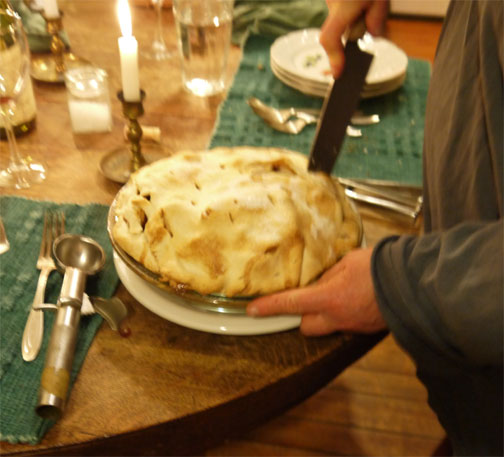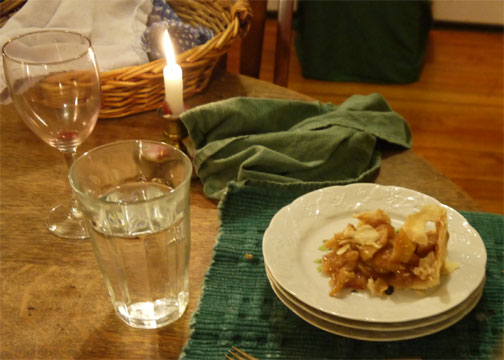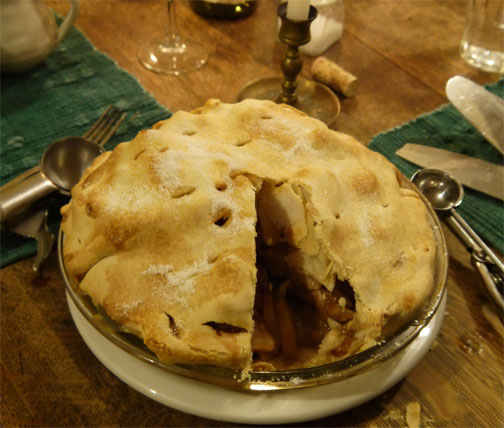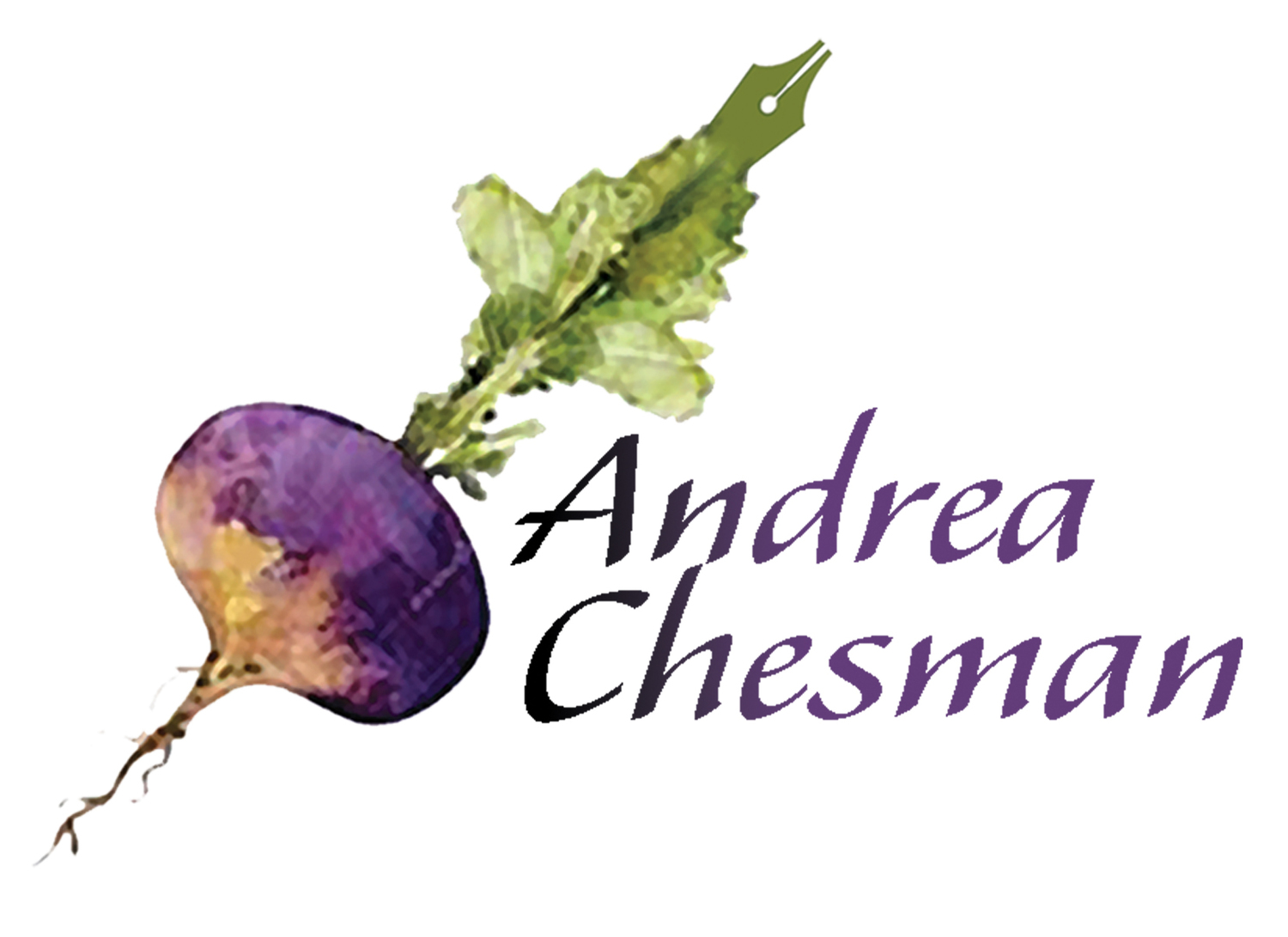Okay, I will admit to the occasional Valentine’s Day splurge for strawberries from Texas or California. But early January? Who needs them?
What we need—all we need—when the sweet tooth beckons is apple: apple eaten out of the hand, in a cake, in a tart, and most certainly in an apple pie. There is nothing more satisfying than apple pie, whether it is served hot from the oven with coffee in the gloom of a wintry afternoon, reheated gently and topped with ice cream for an indulgent dessert, or eaten without apology for breakfast.
 What we need is apple pie.
What we need is apple pie.
Early New Englanders ate apple pie daily and by the 1830s, apple orchards were considered as standard a feature on the average farm as a flock of chickens. New Englanders consumed prodigious amounts of apples in the form of apple cider and apple jack. Fresh, unpasteurized apple cider naturally ferments into hard apple cider; if allowed to freeze, the water separates from the cider, resulting in a more concentrated, alcoholic drink, or applejack.
I digress. Apples are almost always available: fresh and local. Over 1000 varieties of apples have been developed in the US, though only about 250 varieties can be found in commercial heirloom orchards these days. Before refrigeration was developed, before railroads and roads crisscrossed the US, before supermarkets eliminated regional favorites in favor of uniform, ship-anywhere varieties, New Englanders planted varieties of apples that produced apples from late summer through late fall, with the late fall varieties good for keeping in root cellars and springhouses—some, like the Northern Spy, especially good for pies.
I make pie whenever the apples I have bought seem to be languishing in the refrigerator. McIntosh, Gala, Jonathan, Golden Delicious, Northern Spy, Maiden’s Blush. Cortland, Granny Smith, Honeygold, Pink Lady, Rome. It is all good in a pie.
 The first slice always falls apart.
The first slice always falls apart.
 The pie disappears all too quickly.
The pie disappears all too quickly.
Apple Pie
Serves 8
Use 4 pounds of apples so you can mound the apples generously in the pan. This recipe makes an absolutely basic, absolutely perfect, all-American pie.
Pastry for a 9-inch double-crust pie, homemade or store-bought
¾ cup plus 1 tablespoon sugar, or more to taste
2 tablespoons unbleached all-purpose flour
1½ teaspoons ground cinnamon
¼ teaspoon ground allspice
¼ teaspoon freshly grated nutmeg
3½ to 4 pounds tart, crisp apples, peeled, cored, sliced ¼-inch thick (8 cups)
1 teaspoon finely grated lemon zest
1 tablespoon freshly squeezed lemon juice
2 tablespoons butter, cut into small pieces
1 teaspoon milk
Cheddar cheese or vanilla ice cream, to serve
1. If you are making your own pastry, prepare the pie dough and refrigerate.
2. In a large bowl, combine ¾ cup of the sugar, the flour, cinnamon, allspice, and nutmeg. Add the apples; sprinkle with the lemon zest and lemon juice. Toss together to mix thoroughly. If the apples are too tart, add a little extra sugar.
3. Preheat the oven to 425°F with a rack in the lower third of the oven.
4. To prepare the pie shell, lightly flour a work surface. Roll out the larger portion of the chilled dough to a thickness of about 1/8-inch. Fit into a 9-inch pie plate, leaving a 1-inch overhang. (Fit purchased pastry into the pie pan.) Spoon the apple mixture into the pastry, mounding it higher in the center. Dot with butter. Roll out the remaining dough into a circle about 1 inch larger than the pie plate. Moisten the edge of the bottom crust with water. Fold the dough circle in half, lift off the work surface, place the pastry across the center of the filled pie, and unfold. Trim the edge ½ inch larger than the pie plate and tuck the overhang under the edge of the bottom crust. Crimp the edges with a fork or make a fluted pattern with your fingers. Make several decorative slits in the top crust to allow steam to escape. Place the pie on a baking sheet to catch any juices that overflow.
5. Bake the pie in the lower third of the oven for 20 minutes. Reduce the heat to 350°F and continue to bake for 30 minutes. Brush the top of the pie with the milk and sprinkle with the remaining 1 tablespoon of sugar. Bake for 10 to 15 minutes longer, until the crust is golden and the juices are bubbly.
6. Cool the pie on a rack. Serve warm or at room temperature with slices of Cheddar cheese or vanilla ice cream.
Recipe adapted from 250 Trasured Country Desserts by Andrea Chesman and Fran Raboff. ©2009 Andrea Chesman and Fran Raboff. All rights reserved.
